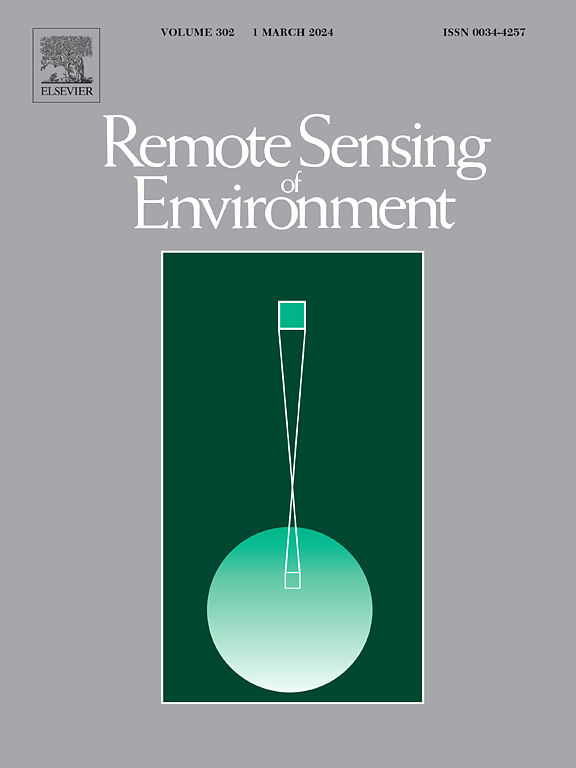Remote sensing-based high-resolution reservoir drought index for identifying the occurrence and propagation of hydrological droughts in a large river basin
IF 11.1
1区 地球科学
Q1 ENVIRONMENTAL SCIENCES
引用次数: 0
Abstract
Reservoir drought is a valuable indicator of regional hydrological drought severity; however, it has received limited attention because of the low quality of reservoir storage data. This study proposes a Remote Sensing-Based High-Resolution Reservoir Drought Index (RS-HRDI) that integrates recent high-resolution satellite observations with historical low-resolution records to construct a long-term reservoir storage dataset. Reservoir droughts are identified by periods of abnormally low reservoir storage using a time-variant threshold. The RS-HRDI was used to detect reservoir droughts in the Yangtze River Basin, one of the most reservoir-regulated and critical river systems globally, from 2018 to 2023, including a record-breaking drought in 2022. The results indicate that the multi-satellite combination significantly improved the reservoir observation frequency from the historical monthly scale to an average of 4.3 d, enabling the detection of rapid reservoir storage reductions within days. The RS-HRDI could effectively identify droughts across various reservoirs and accurately describe their characteristics. Through comprehensive assessments of widespread reservoir networks, the aggregated RS-HRDI effectively characterized basin-scale hydrological droughts, detailing their spatial extent, intensity, and duration. Furthermore, the RS-HRDI highlighted the influence of reservoir operations on the occurrence and propagation of hydrological droughts in a river system. Specifically, upstream reservoir interception advanced downstream droughts by 2–40 d. This study presents a novel reservoir drought assessment method based on remote sensing, highlighting its potential for use in large-scale and timely hydrological drought monitoring and water resource management.
基于遥感的高分辨率水库干旱指数识别大流域水文干旱的发生与传播
水库干旱是反映区域水文干旱严重程度的重要指标;然而,由于储层存储数据质量不高,其受到的关注有限。本研究提出了基于遥感的高分辨率水库干旱指数(RS-HRDI),该指数将近期高分辨率卫星观测数据与历史低分辨率记录相结合,构建了一个长期的水库存储数据集。水库干旱是通过使用时变阈值的异常低水库蓄水量来识别的。RS-HRDI用于检测2018年至2023年长江流域的水库干旱,包括2022年创纪录的干旱。长江流域是全球最受水库调节和关键的河流系统之一。结果表明,多卫星组合将水库观测频率从历史月尺度显著提高到平均4.3 d,能够在天内检测到水库库存量的快速减少。RS-HRDI可以有效识别不同水库的干旱,准确描述其特征。通过对广泛的水库网络进行综合评价,RS-HRDI有效地表征了流域尺度的水文干旱,详细描述了其空间范围、强度和持续时间。此外,RS-HRDI还强调了水库运行对水系水文干旱发生和传播的影响。该研究提出了一种基于遥感的水库干旱评价新方法,突出了其在大规模、及时的水文干旱监测和水资源管理中的应用潜力。
本文章由计算机程序翻译,如有差异,请以英文原文为准。
求助全文
约1分钟内获得全文
求助全文
来源期刊

Remote Sensing of Environment
环境科学-成像科学与照相技术
CiteScore
25.10
自引率
8.90%
发文量
455
审稿时长
53 days
期刊介绍:
Remote Sensing of Environment (RSE) serves the Earth observation community by disseminating results on the theory, science, applications, and technology that contribute to advancing the field of remote sensing. With a thoroughly interdisciplinary approach, RSE encompasses terrestrial, oceanic, and atmospheric sensing.
The journal emphasizes biophysical and quantitative approaches to remote sensing at local to global scales, covering a diverse range of applications and techniques.
RSE serves as a vital platform for the exchange of knowledge and advancements in the dynamic field of remote sensing.
 求助内容:
求助内容: 应助结果提醒方式:
应助结果提醒方式:


